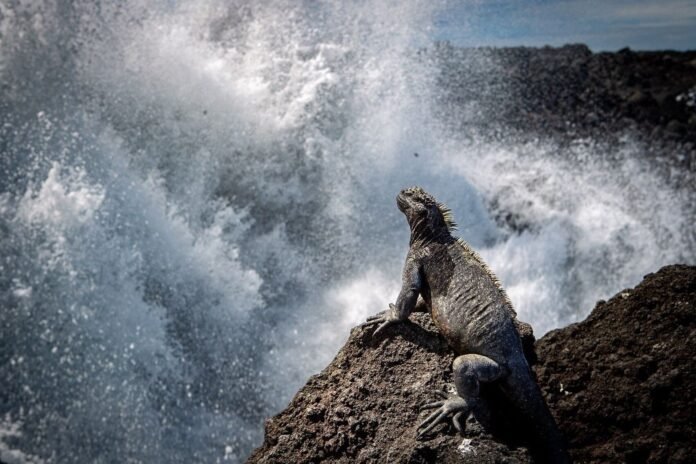
Nearly 14,000 volunteers took part in the citizen science project Iguanas from Above, helping to count endangered Galapagos marine iguanas through an online survey—and in doing so, contributed to the preservation of this unique lizard species. Every aerial image of the iguana colonies captured by drones was reviewed by at least 20 independent participants—a total of more than 1.3 million inputs, explains campaign leader Dr. Amy MacLeod from Leipzig University’s Institute of Biology.
She concludes that citizen scientists can be deployed effectively to analyze drone data sets and estimate population sizes, thereby allowing researchers to obtain critical information on these marine iguanas more rapidly. MacLeod and her team have just published a paper on the project in the journal Scientific Reports.
Galapagos marine iguanas are found only on the archipelago in the eastern Pacific. Until now, their population has never been fully recorded, as many of their colonies are difficult to access. These challenges can hinder the effective protection of the species. That’s why researchers at Leipzig University launched the project in 2020.
“We developed a new method using drones to capture images from which the animals can be counted. We also launched the citizen science project Iguanas from Above, which allows people to help with the count online,” explains the zoologist.
Reliable results, however, depended on the quality of the images. “In the pilot phase, lower-quality photos led to more errors. In overcrowded or visually complex images, volunteers were more likely to miss animals. There was a general tendency to undercount. Their motivation was strongly influenced by how clearly the tasks were explained and by the project design. Some volunteers completed thousands of classifications,” says MacLeod.

The use of new technologies such as drones is becoming increasingly popular in nature conservation. However, this also generates large sets of image data, the analysis of which can be extremely time-consuming. While public involvement in data collection is already widespread, this new study shows that volunteers can also reliably analyze data.
“This expands the role of citizen science, provides significant support for researchers, and offers a valuable opportunity to actively engage people in conservation topics,” says the campaign leader. Although the researchers plan to use artificial intelligence for future counts, initial tests have shown that volunteers working online are currently still better suited to the task.
For their surveys, they used drones launched both from boats and from land to capture aerial images of the colonies. Traditional ground surveys were also carried out in parallel. The drone images were uploaded to the Zooniverse platform, where volunteers marked the marine iguanas.
MacLeod and her team are testing various methods for aggregating the data in order to evaluate the results and compare them statistically with expert counts. “We show that citizen scientists can be used to evaluate such data sets, and we present a new method for making optimal use of aggregated data.
“This approach enables cost-effective monitoring of hard-to-reach wildlife populations,” says the researcher, adding that the methodology can also be applied to other species and habitats and provides a foundation for the future automation of such projects using AI. The researchers are also sharing volunteer feedback with other scientists and offering insights into their experience with the project—which could benefit other initiatives looking to use citizen science for data analysis.
The Iguanas from Above project is still ongoing. The researchers will use citizen science results from selected sites across the Galapagos archipelago to pursue their overarching goal: the first complete, detailed population survey of this species. The publication of their population estimates is planned for early 2026. The data will also contribute to an updated IUCN Red List assessment and help inform effective conservation measures.
More information:
Andrea Varela-Jaramillo et al, Citizen scientists reliably count endangered Galápagos marine iguanas from drone images, Scientific Reports (2025). DOI: 10.1038/s41598-025-08381-9
Provided by
Leipzig University
Citation:
Citizen scientists help count Galapagos marine iguanas using drone images (2025, July 25)
retrieved 25 July 2025
from https://phys.org/news/2025-07-citizen-scientists-galapagos-marine-iguanas.html
This document is subject to copyright. Apart from any fair dealing for the purpose of private study or research, no
part may be reproduced without the written permission. The content is provided for information purposes only.






